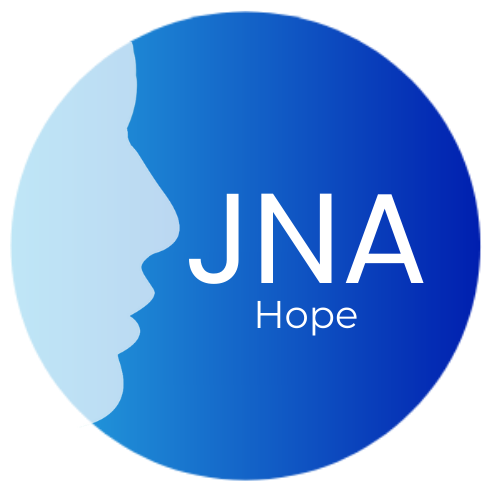
Complications from JNA:
The Importance of Early Detection
Juvenile Nasopharyngeal Angiofibroma (JNA), while non-cancerous, can lead to significant complications if left untreated. Recognizing and addressing these potential issues early is crucial for the well-being of affected boys.

Facial Deformity
As JNA progresses, it can cause noticeable changes in facial appearance, including swelling and facial asymmetry. In advanced stages, the tumor’s growth may lead to pronounced facial deformity. Early detection and treatment can help prevent or mitigate these alterations, allowing individuals to maintain a more normal appearance.
Vision and Hearing Loss
The proximity of the tumor to critical structures like the optic nerve and auditory system increases the risk of vision and hearing impairment. Advanced JNA can result in blindness, double-vision, or hearing loss. Early diagnosis and intervention are essential to preserve vision and hearing and prevent permanent damage.



Facial Deformity
As JNA progresses, it can cause noticeable changes in facial appearance, including swelling and facial asymmetry. In advanced stages, the tumor’s growth may lead to pronounced facial deformity. Early detection and treatment can help prevent or mitigate these alterations, allowing individuals to maintain a more normal appearance.
Vision and Hearing Loss
The proximity of the tumor to critical structures like the optic nerve and auditory system increases the risk of vision and hearing impairment. Advanced JNA can result in blindness, double-vision, or hearing loss. Early diagnosis and intervention are essential to preserve vision and hearing and prevent permanent damage.


Respiratory Distress
As the tumor grows, it may obstruct the nasal passages, leading to nasal congestion and breathing difficulties. In severe cases, individuals may experience sleep apnea, a condition that disrupts normal breathing during sleep. Timely treatment can alleviate respiratory distress and ensure proper airflow.
Severe Nosebleeds
JNA’s highly vascular nature can cause severe and recurrent nosebleeds. These nosebleeds, if left unaddressed, can lead to substantial blood loss, anemia, and complications associated with excessive bleeding. Early detection allows for intervention to manage and control nosebleeds effectively.


Respiratory Distress
As the tumor grows, it may obstruct the nasal passages, leading to nasal congestion and breathing difficulties. In severe cases, individuals may experience sleep apnea, a condition that disrupts normal breathing during sleep. Timely treatment can alleviate respiratory distress and ensure proper airflow.
Severe Nosebleeds
JNA’s highly vascular nature can cause severe and recurrent nosebleeds. These nosebleeds, if left unaddressed, can lead to substantial blood loss, anemia, and complications associated with excessive bleeding. Early detection allows for intervention to manage and control nosebleeds effectively.

Neurological Issues
In some cases, JNA can exert pressure on nearby nerves, resulting in neurological symptoms such as facial numbness or speech difficulties. Early diagnosis is critical to prevent further nerve damage and improve the chances of a full recovery.
Spread of Tumor
While JNA is typically localized, it can occasionally extend into adjacent areas, increasing the complexity of treatment and the risk of complications. Early detection ensures that the tumor can be addressed before it spreads, simplifying treatment and improving outcomes



Neurological Issues
In some cases, JNA can exert pressure on nearby nerves, resulting in neurological symptoms such as facial numbness or speech difficulties. Early diagnosis is critical to prevent further nerve damage and improve the chances of a full recovery.
Spread of Tumor
While JNA is typically localized, it can occasionally extend into adjacent areas, increasing the complexity of treatment and the risk of complications. Early detection ensures that the tumor can be addressed before it spreads, simplifying treatment and improving outcomes


Psychosocial Impact
Beyond physical complications, JNA can also have a psychosocial impact on affected individuals, particularly adolescents. Facial deformity, vision or hearing loss, and speech difficulties can lead to self-esteem issues and emotional distress. Early intervention can help mitigate these psychosocial challenges.


Psychosocial Impact
Beyond physical complications, JNA can also have a psychosocial impact on affected individuals, particularly adolescents. Facial deformity, vision or hearing loss, and speech difficulties can lead to self-esteem issues and emotional distress. Early intervention can help mitigate these psychosocial challenges.

While JNA is not cancerous, it can have detrimental effects if not treated promptly. Early detection and intervention are essential to prevent or minimize complications, preserve quality of life, and improve overall outcomes. Parents should remain vigilant for potential JNA symptoms and seek medical attention if they suspect their child may be affected.
